GRAB's Expansion into Brunei: An International HRM Report
VerifiedAdded on 2020/10/05
|24
|5890
|182
Report
AI Summary
This report provides a comprehensive analysis of GRAB's planned expansion into Brunei, focusing on the implementation of effective international Human Resource Management (HRM) strategies. The report begins with an overview of GRAB and the economic drivers influencing Brunei's business environment, including GDP, income, unemployment, inflation, and interest rates. A PESTLE analysis is then conducted to evaluate the political, economic, social, technological, legal, and environmental factors affecting GRAB's operations. The report then explores various HRM models, such as the Fombrun, Harvard, Guest, Warwick, and John Sorey models, to provide a theoretical framework for HRM practices. The core of the report addresses key HRM functions, including strategic HRM policies, recruitment and selection procedures, training and development measures, performance management systems, and compensation and benefits, with specific recommendations tailored to the Brunei context. Finally, the report concludes with recommendations for GRAB's board of directors, highlighting critical issues and strategies for successful global HRM implementation in Brunei, ensuring employee commitment, flexibility, quality, and strategic integration.

Paraphrase This Document
Need a fresh take? Get an instant paraphrase of this document with our AI Paraphraser
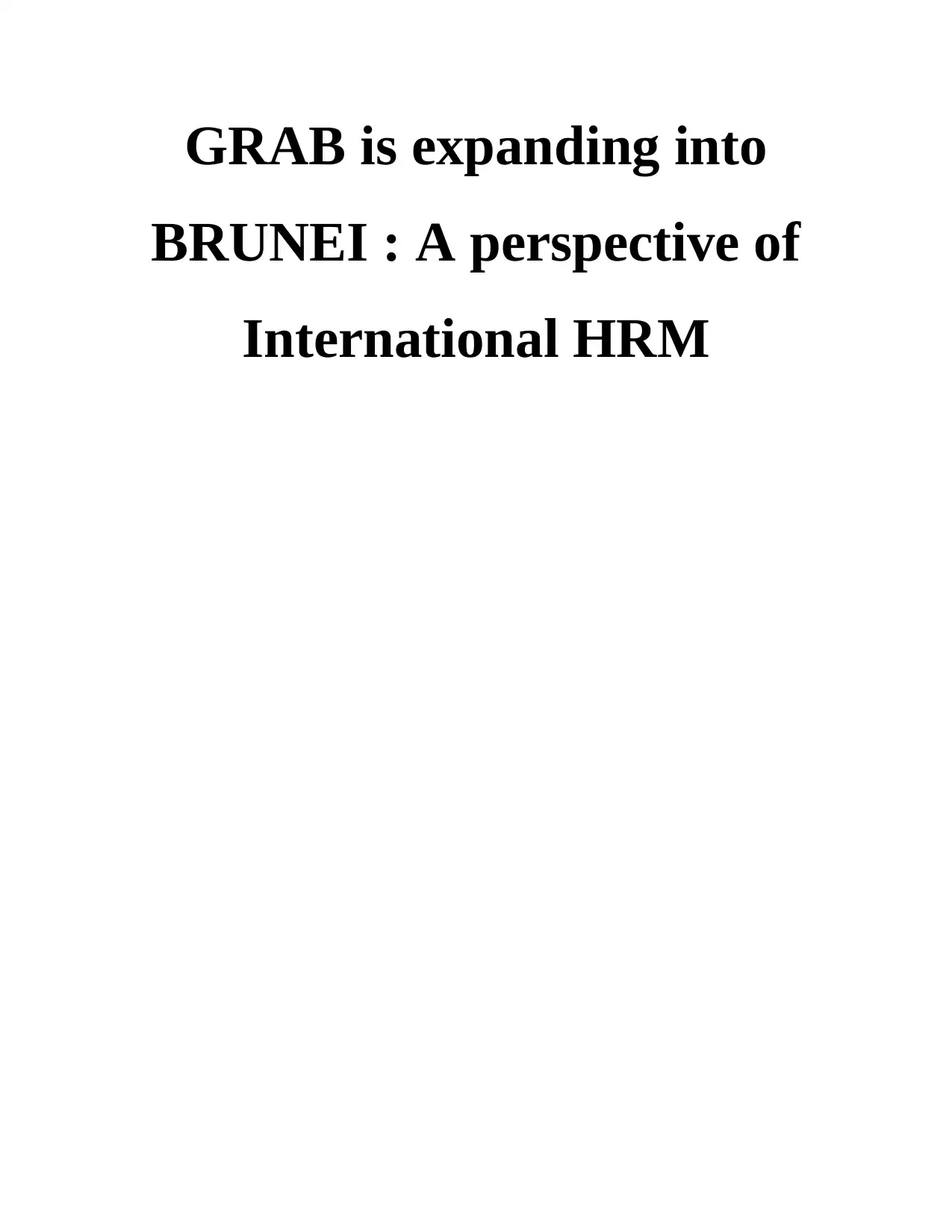
GRAB is expanding into
BRUNEI : A perspective of
International HRM
BRUNEI : A perspective of
International HRM
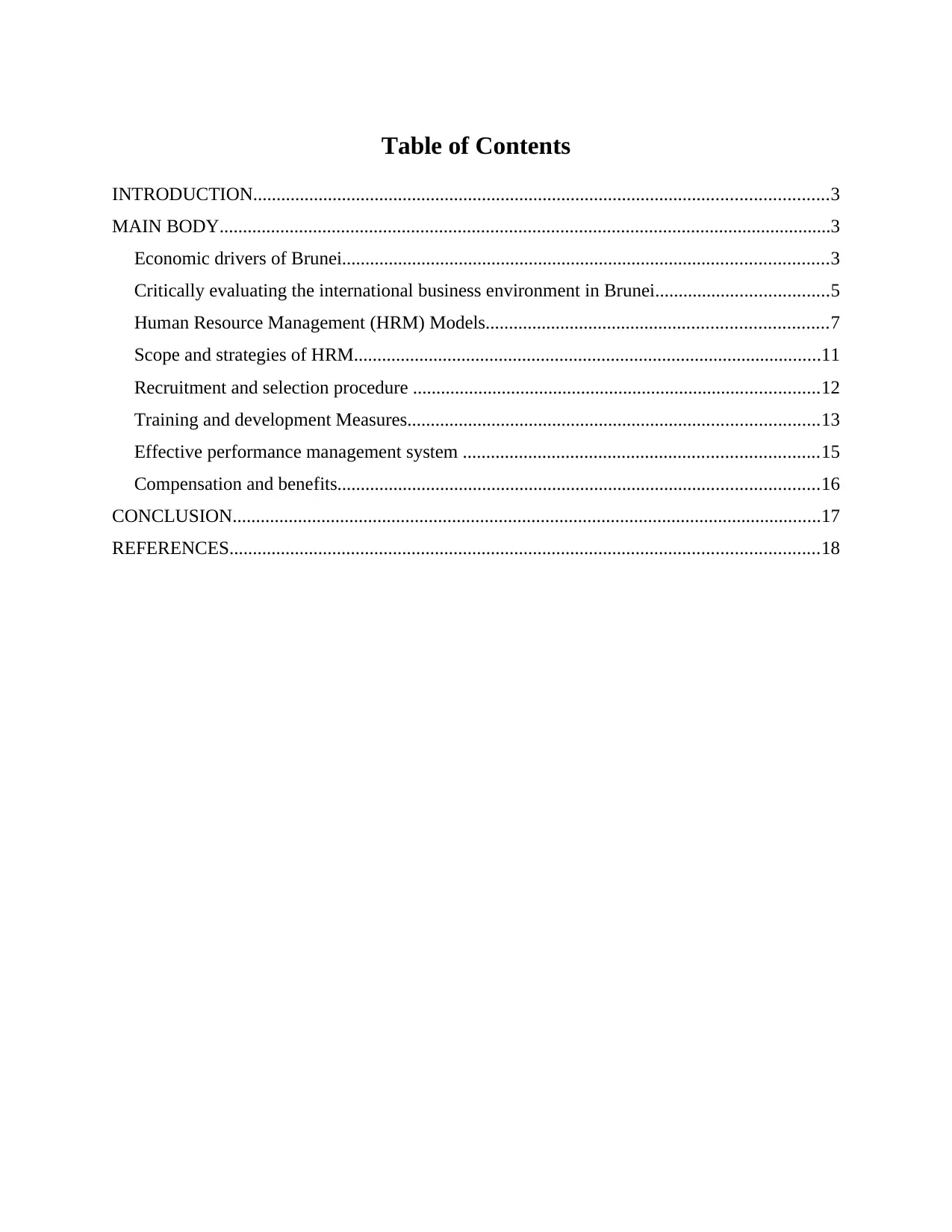
Table of Contents
INTRODUCTION...........................................................................................................................3
MAIN BODY...................................................................................................................................3
Economic drivers of Brunei........................................................................................................3
Critically evaluating the international business environment in Brunei.....................................5
Human Resource Management (HRM) Models.........................................................................7
Scope and strategies of HRM....................................................................................................11
Recruitment and selection procedure .......................................................................................12
Training and development Measures........................................................................................13
Effective performance management system ............................................................................15
Compensation and benefits.......................................................................................................16
CONCLUSION..............................................................................................................................17
REFERENCES..............................................................................................................................18
INTRODUCTION...........................................................................................................................3
MAIN BODY...................................................................................................................................3
Economic drivers of Brunei........................................................................................................3
Critically evaluating the international business environment in Brunei.....................................5
Human Resource Management (HRM) Models.........................................................................7
Scope and strategies of HRM....................................................................................................11
Recruitment and selection procedure .......................................................................................12
Training and development Measures........................................................................................13
Effective performance management system ............................................................................15
Compensation and benefits.......................................................................................................16
CONCLUSION..............................................................................................................................17
REFERENCES..............................................................................................................................18
⊘ This is a preview!⊘
Do you want full access?
Subscribe today to unlock all pages.

Trusted by 1+ million students worldwide
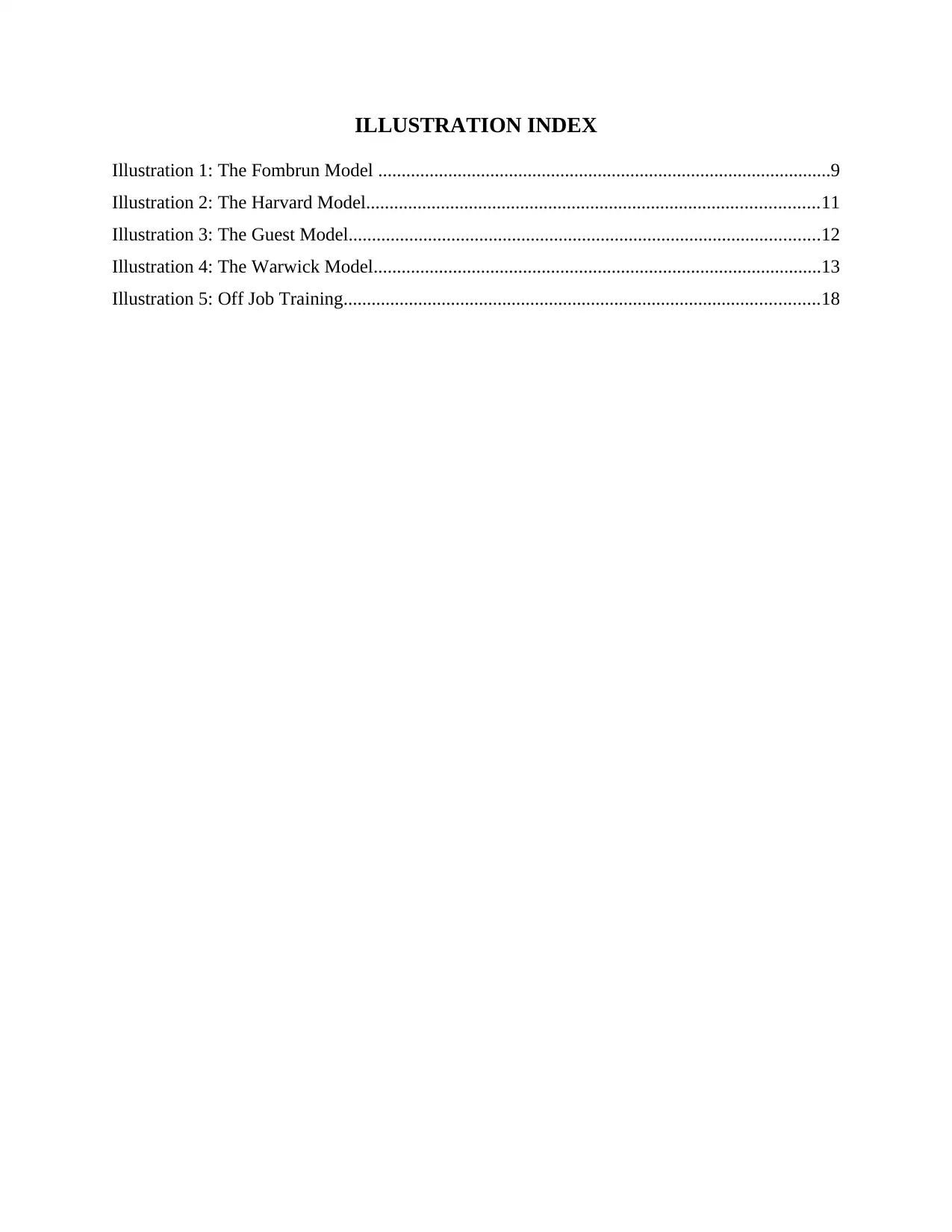
ILLUSTRATION INDEX
Illustration 1: The Fombrun Model .................................................................................................9
Illustration 2: The Harvard Model.................................................................................................11
Illustration 3: The Guest Model.....................................................................................................12
Illustration 4: The Warwick Model................................................................................................13
Illustration 5: Off Job Training......................................................................................................18
Illustration 1: The Fombrun Model .................................................................................................9
Illustration 2: The Harvard Model.................................................................................................11
Illustration 3: The Guest Model.....................................................................................................12
Illustration 4: The Warwick Model................................................................................................13
Illustration 5: Off Job Training......................................................................................................18
Paraphrase This Document
Need a fresh take? Get an instant paraphrase of this document with our AI Paraphraser
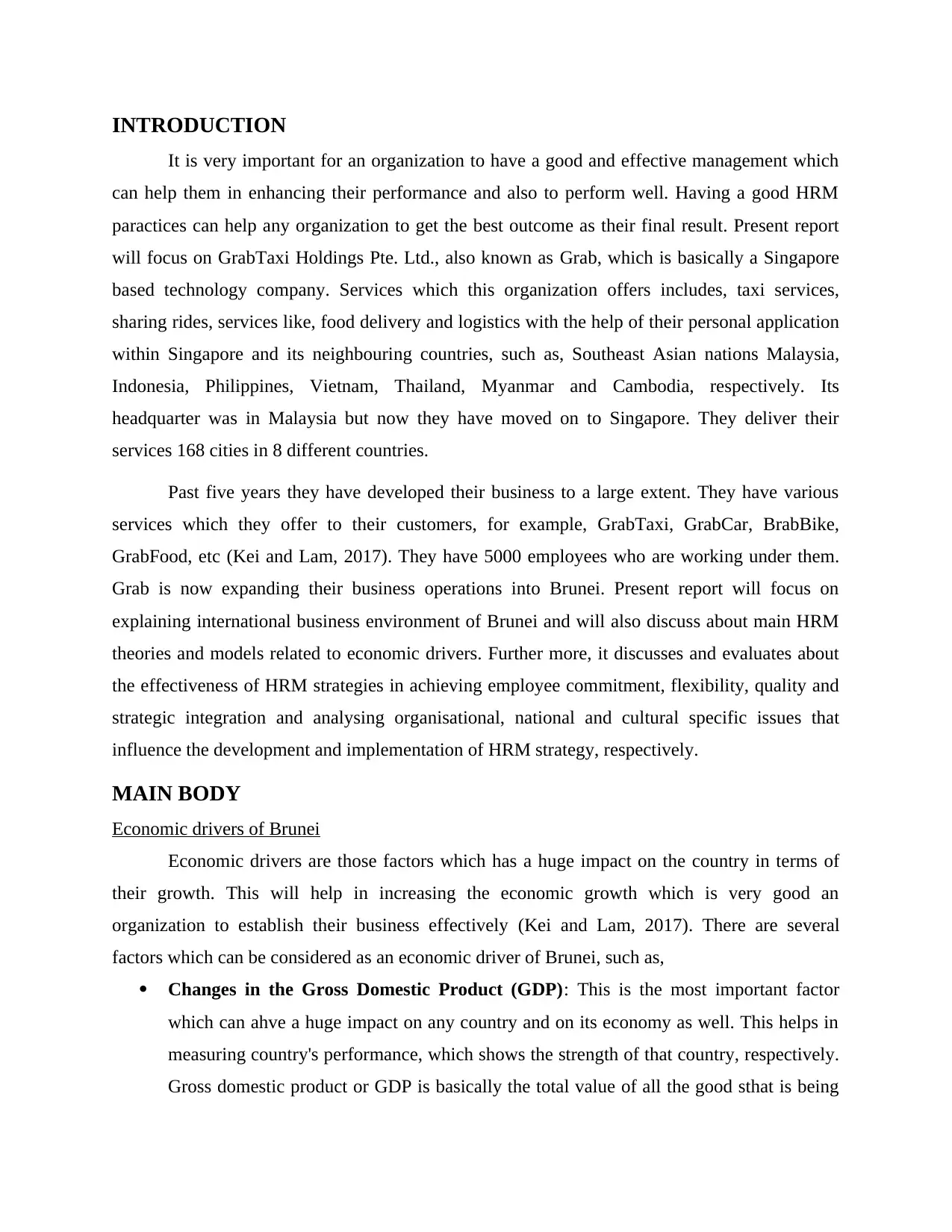
INTRODUCTION
It is very important for an organization to have a good and effective management which
can help them in enhancing their performance and also to perform well. Having a good HRM
paractices can help any organization to get the best outcome as their final result. Present report
will focus on GrabTaxi Holdings Pte. Ltd., also known as Grab, which is basically a Singapore
based technology company. Services which this organization offers includes, taxi services,
sharing rides, services like, food delivery and logistics with the help of their personal application
within Singapore and its neighbouring countries, such as, Southeast Asian nations Malaysia,
Indonesia, Philippines, Vietnam, Thailand, Myanmar and Cambodia, respectively. Its
headquarter was in Malaysia but now they have moved on to Singapore. They deliver their
services 168 cities in 8 different countries.
Past five years they have developed their business to a large extent. They have various
services which they offer to their customers, for example, GrabTaxi, GrabCar, BrabBike,
GrabFood, etc (Kei and Lam, 2017). They have 5000 employees who are working under them.
Grab is now expanding their business operations into Brunei. Present report will focus on
explaining international business environment of Brunei and will also discuss about main HRM
theories and models related to economic drivers. Further more, it discusses and evaluates about
the effectiveness of HRM strategies in achieving employee commitment, flexibility, quality and
strategic integration and analysing organisational, national and cultural specific issues that
influence the development and implementation of HRM strategy, respectively.
MAIN BODY
Economic drivers of Brunei
Economic drivers are those factors which has a huge impact on the country in terms of
their growth. This will help in increasing the economic growth which is very good an
organization to establish their business effectively (Kei and Lam, 2017). There are several
factors which can be considered as an economic driver of Brunei, such as,
Changes in the Gross Domestic Product (GDP): This is the most important factor
which can ahve a huge impact on any country and on its economy as well. This helps in
measuring country's performance, which shows the strength of that country, respectively.
Gross domestic product or GDP is basically the total value of all the good sthat is being
It is very important for an organization to have a good and effective management which
can help them in enhancing their performance and also to perform well. Having a good HRM
paractices can help any organization to get the best outcome as their final result. Present report
will focus on GrabTaxi Holdings Pte. Ltd., also known as Grab, which is basically a Singapore
based technology company. Services which this organization offers includes, taxi services,
sharing rides, services like, food delivery and logistics with the help of their personal application
within Singapore and its neighbouring countries, such as, Southeast Asian nations Malaysia,
Indonesia, Philippines, Vietnam, Thailand, Myanmar and Cambodia, respectively. Its
headquarter was in Malaysia but now they have moved on to Singapore. They deliver their
services 168 cities in 8 different countries.
Past five years they have developed their business to a large extent. They have various
services which they offer to their customers, for example, GrabTaxi, GrabCar, BrabBike,
GrabFood, etc (Kei and Lam, 2017). They have 5000 employees who are working under them.
Grab is now expanding their business operations into Brunei. Present report will focus on
explaining international business environment of Brunei and will also discuss about main HRM
theories and models related to economic drivers. Further more, it discusses and evaluates about
the effectiveness of HRM strategies in achieving employee commitment, flexibility, quality and
strategic integration and analysing organisational, national and cultural specific issues that
influence the development and implementation of HRM strategy, respectively.
MAIN BODY
Economic drivers of Brunei
Economic drivers are those factors which has a huge impact on the country in terms of
their growth. This will help in increasing the economic growth which is very good an
organization to establish their business effectively (Kei and Lam, 2017). There are several
factors which can be considered as an economic driver of Brunei, such as,
Changes in the Gross Domestic Product (GDP): This is the most important factor
which can ahve a huge impact on any country and on its economy as well. This helps in
measuring country's performance, which shows the strength of that country, respectively.
Gross domestic product or GDP is basically the total value of all the good sthat is being
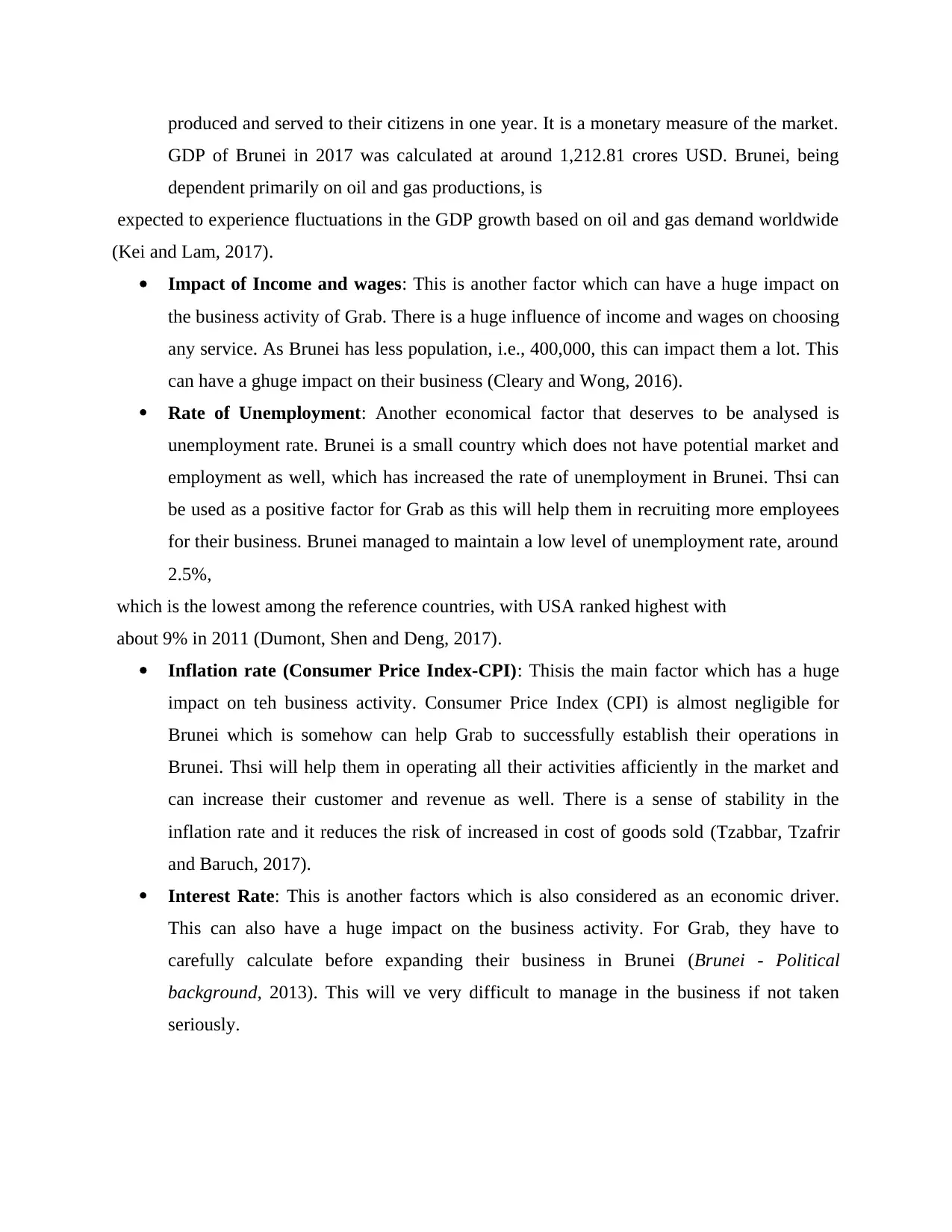
produced and served to their citizens in one year. It is a monetary measure of the market.
GDP of Brunei in 2017 was calculated at around 1,212.81 crores USD. Brunei, being
dependent primarily on oil and gas productions, is
expected to experience fluctuations in the GDP growth based on oil and gas demand worldwide
(Kei and Lam, 2017).
Impact of Income and wages: This is another factor which can have a huge impact on
the business activity of Grab. There is a huge influence of income and wages on choosing
any service. As Brunei has less population, i.e., 400,000, this can impact them a lot. This
can have a ghuge impact on their business (Cleary and Wong, 2016).
Rate of Unemployment: Another economical factor that deserves to be analysed is
unemployment rate. Brunei is a small country which does not have potential market and
employment as well, which has increased the rate of unemployment in Brunei. Thsi can
be used as a positive factor for Grab as this will help them in recruiting more employees
for their business. Brunei managed to maintain a low level of unemployment rate, around
2.5%,
which is the lowest among the reference countries, with USA ranked highest with
about 9% in 2011 (Dumont, Shen and Deng, 2017).
Inflation rate (Consumer Price Index-CPI): Thisis the main factor which has a huge
impact on teh business activity. Consumer Price Index (CPI) is almost negligible for
Brunei which is somehow can help Grab to successfully establish their operations in
Brunei. Thsi will help them in operating all their activities afficiently in the market and
can increase their customer and revenue as well. There is a sense of stability in the
inflation rate and it reduces the risk of increased in cost of goods sold (Tzabbar, Tzafrir
and Baruch, 2017).
Interest Rate: This is another factors which is also considered as an economic driver.
This can also have a huge impact on the business activity. For Grab, they have to
carefully calculate before expanding their business in Brunei (Brunei - Political
background, 2013). This will ve very difficult to manage in the business if not taken
seriously.
GDP of Brunei in 2017 was calculated at around 1,212.81 crores USD. Brunei, being
dependent primarily on oil and gas productions, is
expected to experience fluctuations in the GDP growth based on oil and gas demand worldwide
(Kei and Lam, 2017).
Impact of Income and wages: This is another factor which can have a huge impact on
the business activity of Grab. There is a huge influence of income and wages on choosing
any service. As Brunei has less population, i.e., 400,000, this can impact them a lot. This
can have a ghuge impact on their business (Cleary and Wong, 2016).
Rate of Unemployment: Another economical factor that deserves to be analysed is
unemployment rate. Brunei is a small country which does not have potential market and
employment as well, which has increased the rate of unemployment in Brunei. Thsi can
be used as a positive factor for Grab as this will help them in recruiting more employees
for their business. Brunei managed to maintain a low level of unemployment rate, around
2.5%,
which is the lowest among the reference countries, with USA ranked highest with
about 9% in 2011 (Dumont, Shen and Deng, 2017).
Inflation rate (Consumer Price Index-CPI): Thisis the main factor which has a huge
impact on teh business activity. Consumer Price Index (CPI) is almost negligible for
Brunei which is somehow can help Grab to successfully establish their operations in
Brunei. Thsi will help them in operating all their activities afficiently in the market and
can increase their customer and revenue as well. There is a sense of stability in the
inflation rate and it reduces the risk of increased in cost of goods sold (Tzabbar, Tzafrir
and Baruch, 2017).
Interest Rate: This is another factors which is also considered as an economic driver.
This can also have a huge impact on the business activity. For Grab, they have to
carefully calculate before expanding their business in Brunei (Brunei - Political
background, 2013). This will ve very difficult to manage in the business if not taken
seriously.
⊘ This is a preview!⊘
Do you want full access?
Subscribe today to unlock all pages.

Trusted by 1+ million students worldwide
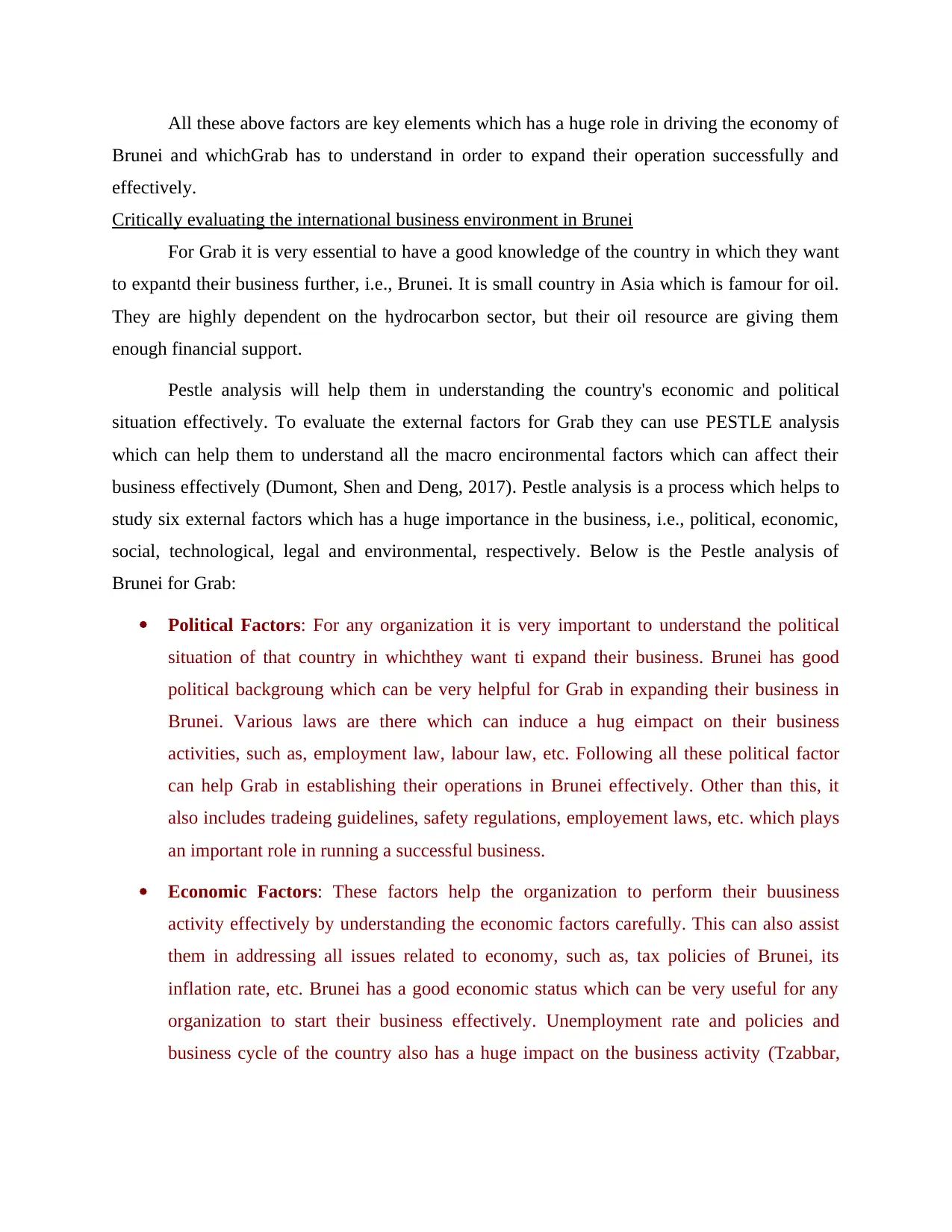
All these above factors are key elements which has a huge role in driving the economy of
Brunei and whichGrab has to understand in order to expand their operation successfully and
effectively.
Critically evaluating the international business environment in Brunei
For Grab it is very essential to have a good knowledge of the country in which they want
to expantd their business further, i.e., Brunei. It is small country in Asia which is famour for oil.
They are highly dependent on the hydrocarbon sector, but their oil resource are giving them
enough financial support.
Pestle analysis will help them in understanding the country's economic and political
situation effectively. To evaluate the external factors for Grab they can use PESTLE analysis
which can help them to understand all the macro encironmental factors which can affect their
business effectively (Dumont, Shen and Deng, 2017). Pestle analysis is a process which helps to
study six external factors which has a huge importance in the business, i.e., political, economic,
social, technological, legal and environmental, respectively. Below is the Pestle analysis of
Brunei for Grab:
Political Factors: For any organization it is very important to understand the political
situation of that country in whichthey want ti expand their business. Brunei has good
political backgroung which can be very helpful for Grab in expanding their business in
Brunei. Various laws are there which can induce a hug eimpact on their business
activities, such as, employment law, labour law, etc. Following all these political factor
can help Grab in establishing their operations in Brunei effectively. Other than this, it
also includes tradeing guidelines, safety regulations, employement laws, etc. which plays
an important role in running a successful business.
Economic Factors: These factors help the organization to perform their buusiness
activity effectively by understanding the economic factors carefully. This can also assist
them in addressing all issues related to economy, such as, tax policies of Brunei, its
inflation rate, etc. Brunei has a good economic status which can be very useful for any
organization to start their business effectively. Unemployment rate and policies and
business cycle of the country also has a huge impact on the business activity (Tzabbar,
Brunei and whichGrab has to understand in order to expand their operation successfully and
effectively.
Critically evaluating the international business environment in Brunei
For Grab it is very essential to have a good knowledge of the country in which they want
to expantd their business further, i.e., Brunei. It is small country in Asia which is famour for oil.
They are highly dependent on the hydrocarbon sector, but their oil resource are giving them
enough financial support.
Pestle analysis will help them in understanding the country's economic and political
situation effectively. To evaluate the external factors for Grab they can use PESTLE analysis
which can help them to understand all the macro encironmental factors which can affect their
business effectively (Dumont, Shen and Deng, 2017). Pestle analysis is a process which helps to
study six external factors which has a huge importance in the business, i.e., political, economic,
social, technological, legal and environmental, respectively. Below is the Pestle analysis of
Brunei for Grab:
Political Factors: For any organization it is very important to understand the political
situation of that country in whichthey want ti expand their business. Brunei has good
political backgroung which can be very helpful for Grab in expanding their business in
Brunei. Various laws are there which can induce a hug eimpact on their business
activities, such as, employment law, labour law, etc. Following all these political factor
can help Grab in establishing their operations in Brunei effectively. Other than this, it
also includes tradeing guidelines, safety regulations, employement laws, etc. which plays
an important role in running a successful business.
Economic Factors: These factors help the organization to perform their buusiness
activity effectively by understanding the economic factors carefully. This can also assist
them in addressing all issues related to economy, such as, tax policies of Brunei, its
inflation rate, etc. Brunei has a good economic status which can be very useful for any
organization to start their business effectively. Unemployment rate and policies and
business cycle of the country also has a huge impact on the business activity (Tzabbar,
Paraphrase This Document
Need a fresh take? Get an instant paraphrase of this document with our AI Paraphraser
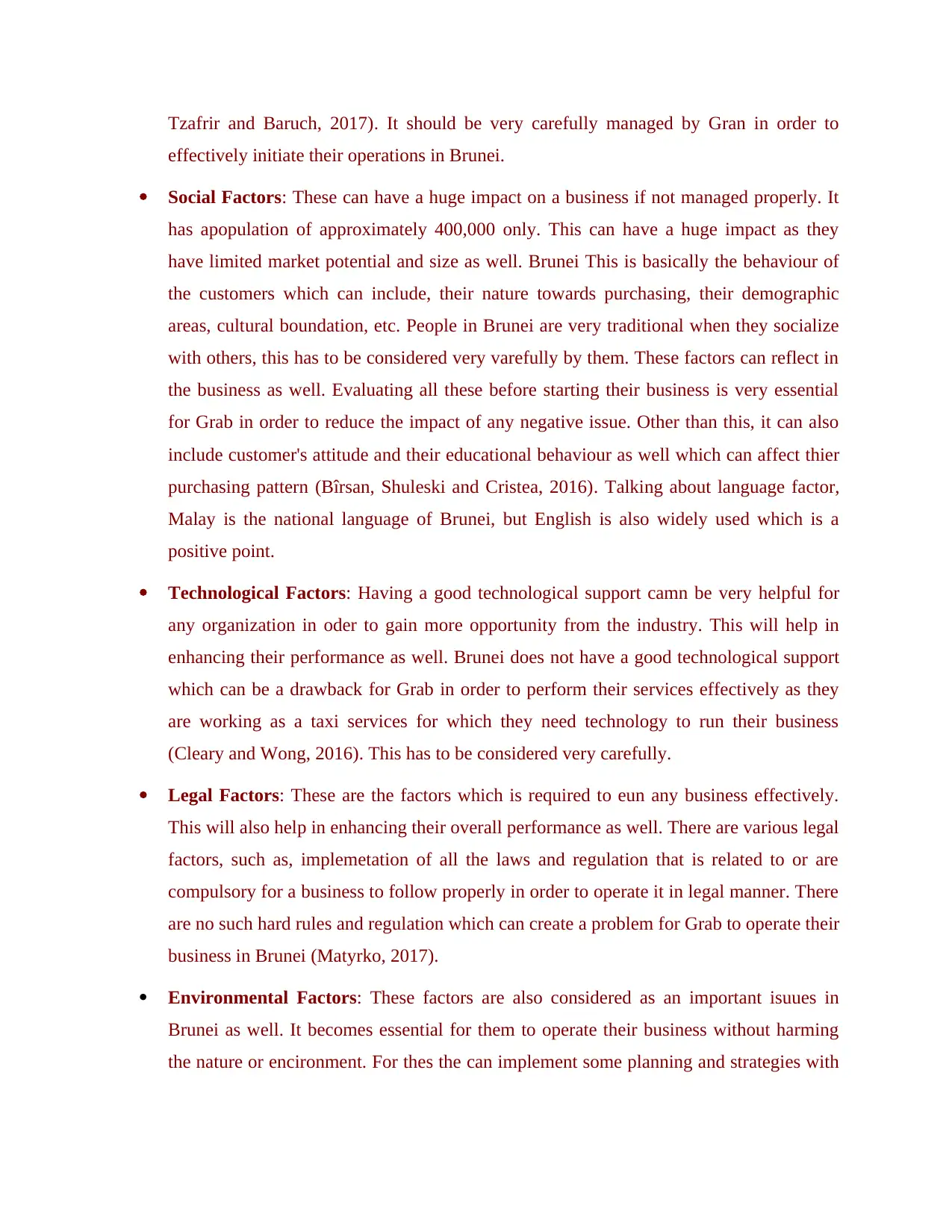
Tzafrir and Baruch, 2017). It should be very carefully managed by Gran in order to
effectively initiate their operations in Brunei.
Social Factors: These can have a huge impact on a business if not managed properly. It
has apopulation of approximately 400,000 only. This can have a huge impact as they
have limited market potential and size as well. Brunei This is basically the behaviour of
the customers which can include, their nature towards purchasing, their demographic
areas, cultural boundation, etc. People in Brunei are very traditional when they socialize
with others, this has to be considered very varefully by them. These factors can reflect in
the business as well. Evaluating all these before starting their business is very essential
for Grab in order to reduce the impact of any negative issue. Other than this, it can also
include customer's attitude and their educational behaviour as well which can affect thier
purchasing pattern (Bîrsan, Shuleski and Cristea, 2016). Talking about language factor,
Malay is the national language of Brunei, but English is also widely used which is a
positive point.
Technological Factors: Having a good technological support camn be very helpful for
any organization in oder to gain more opportunity from the industry. This will help in
enhancing their performance as well. Brunei does not have a good technological support
which can be a drawback for Grab in order to perform their services effectively as they
are working as a taxi services for which they need technology to run their business
(Cleary and Wong, 2016). This has to be considered very carefully.
Legal Factors: These are the factors which is required to eun any business effectively.
This will also help in enhancing their overall performance as well. There are various legal
factors, such as, implemetation of all the laws and regulation that is related to or are
compulsory for a business to follow properly in order to operate it in legal manner. There
are no such hard rules and regulation which can create a problem for Grab to operate their
business in Brunei (Matyrko, 2017).
Environmental Factors: These factors are also considered as an important isuues in
Brunei as well. It becomes essential for them to operate their business without harming
the nature or encironment. For thes the can implement some planning and strategies with
effectively initiate their operations in Brunei.
Social Factors: These can have a huge impact on a business if not managed properly. It
has apopulation of approximately 400,000 only. This can have a huge impact as they
have limited market potential and size as well. Brunei This is basically the behaviour of
the customers which can include, their nature towards purchasing, their demographic
areas, cultural boundation, etc. People in Brunei are very traditional when they socialize
with others, this has to be considered very varefully by them. These factors can reflect in
the business as well. Evaluating all these before starting their business is very essential
for Grab in order to reduce the impact of any negative issue. Other than this, it can also
include customer's attitude and their educational behaviour as well which can affect thier
purchasing pattern (Bîrsan, Shuleski and Cristea, 2016). Talking about language factor,
Malay is the national language of Brunei, but English is also widely used which is a
positive point.
Technological Factors: Having a good technological support camn be very helpful for
any organization in oder to gain more opportunity from the industry. This will help in
enhancing their performance as well. Brunei does not have a good technological support
which can be a drawback for Grab in order to perform their services effectively as they
are working as a taxi services for which they need technology to run their business
(Cleary and Wong, 2016). This has to be considered very carefully.
Legal Factors: These are the factors which is required to eun any business effectively.
This will also help in enhancing their overall performance as well. There are various legal
factors, such as, implemetation of all the laws and regulation that is related to or are
compulsory for a business to follow properly in order to operate it in legal manner. There
are no such hard rules and regulation which can create a problem for Grab to operate their
business in Brunei (Matyrko, 2017).
Environmental Factors: These factors are also considered as an important isuues in
Brunei as well. It becomes essential for them to operate their business without harming
the nature or encironment. For thes the can implement some planning and strategies with
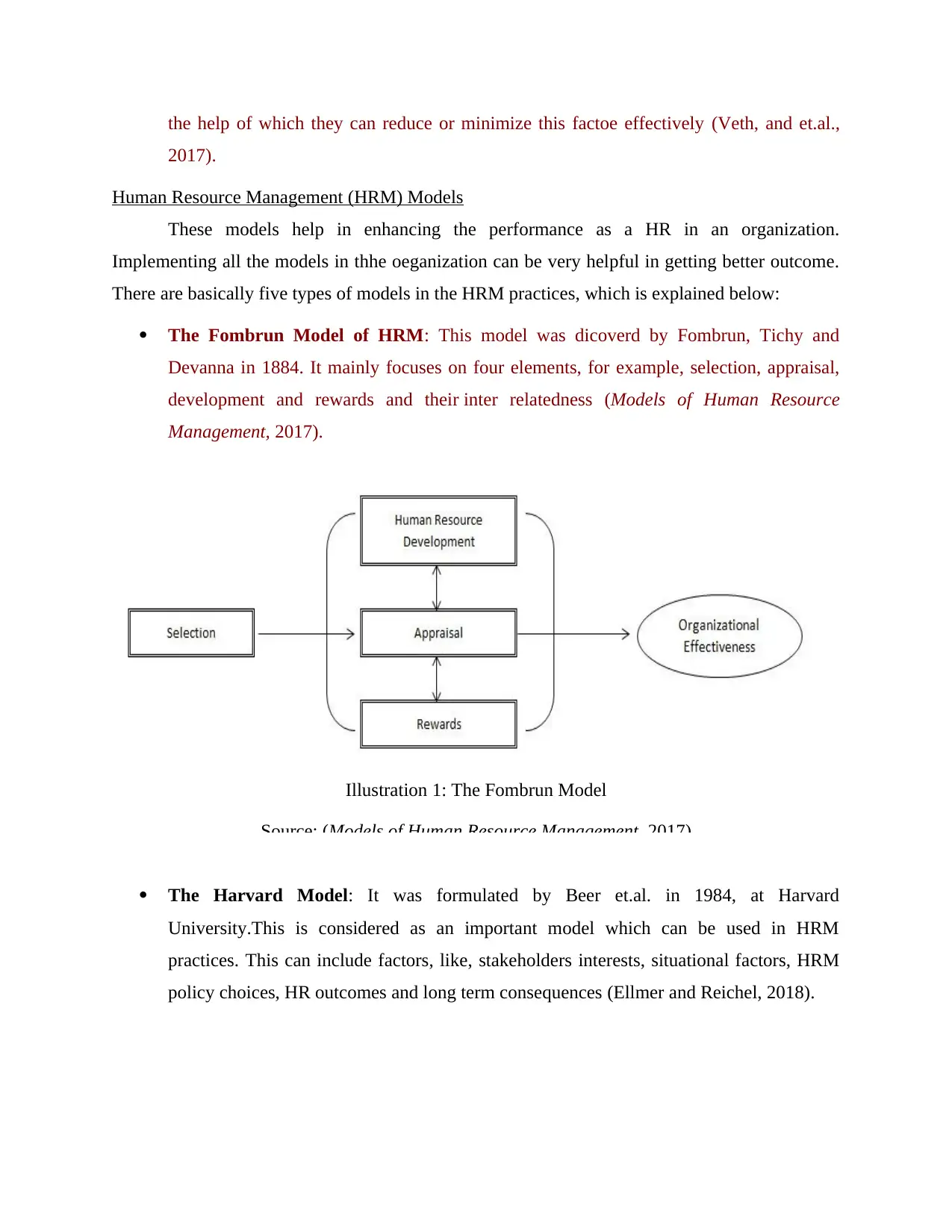
the help of which they can reduce or minimize this factoe effectively (Veth, and et.al.,
2017).
Human Resource Management (HRM) Models
These models help in enhancing the performance as a HR in an organization.
Implementing all the models in thhe oeganization can be very helpful in getting better outcome.
There are basically five types of models in the HRM practices, which is explained below:
The Fombrun Model of HRM: This model was dicoverd by Fombrun, Tichy and
Devanna in 1884. It mainly focuses on four elements, for example, selection, appraisal,
development and rewards and their inter relatedness (Models of Human Resource
Management, 2017).
The Harvard Model: It was formulated by Beer et.al. in 1984, at Harvard
University.This is considered as an important model which can be used in HRM
practices. This can include factors, like, stakeholders interests, situational factors, HRM
policy choices, HR outcomes and long term consequences (Ellmer and Reichel, 2018).
Illustration 1: The Fombrun Model
Source: (Models of Human Resource Management, 2017)
2017).
Human Resource Management (HRM) Models
These models help in enhancing the performance as a HR in an organization.
Implementing all the models in thhe oeganization can be very helpful in getting better outcome.
There are basically five types of models in the HRM practices, which is explained below:
The Fombrun Model of HRM: This model was dicoverd by Fombrun, Tichy and
Devanna in 1884. It mainly focuses on four elements, for example, selection, appraisal,
development and rewards and their inter relatedness (Models of Human Resource
Management, 2017).
The Harvard Model: It was formulated by Beer et.al. in 1984, at Harvard
University.This is considered as an important model which can be used in HRM
practices. This can include factors, like, stakeholders interests, situational factors, HRM
policy choices, HR outcomes and long term consequences (Ellmer and Reichel, 2018).
Illustration 1: The Fombrun Model
Source: (Models of Human Resource Management, 2017)
⊘ This is a preview!⊘
Do you want full access?
Subscribe today to unlock all pages.

Trusted by 1+ million students worldwide
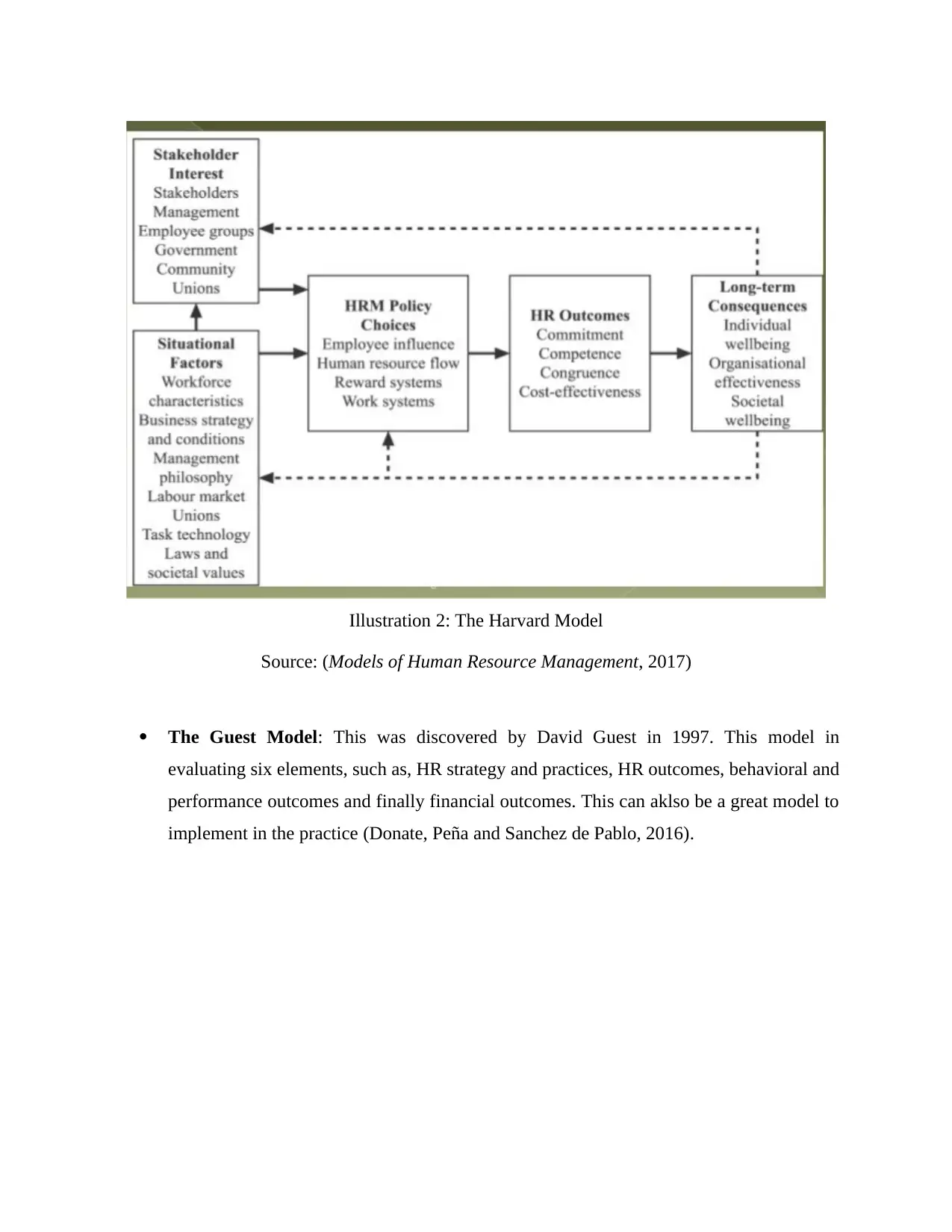
The Guest Model: This was discovered by David Guest in 1997. This model in
evaluating six elements, such as, HR strategy and practices, HR outcomes, behavioral and
performance outcomes and finally financial outcomes. This can aklso be a great model to
implement in the practice (Donate, Peña and Sanchez de Pablo, 2016).
Illustration 2: The Harvard Model
Source: (Models of Human Resource Management, 2017)
evaluating six elements, such as, HR strategy and practices, HR outcomes, behavioral and
performance outcomes and finally financial outcomes. This can aklso be a great model to
implement in the practice (Donate, Peña and Sanchez de Pablo, 2016).
Illustration 2: The Harvard Model
Source: (Models of Human Resource Management, 2017)
Paraphrase This Document
Need a fresh take? Get an instant paraphrase of this document with our AI Paraphraser
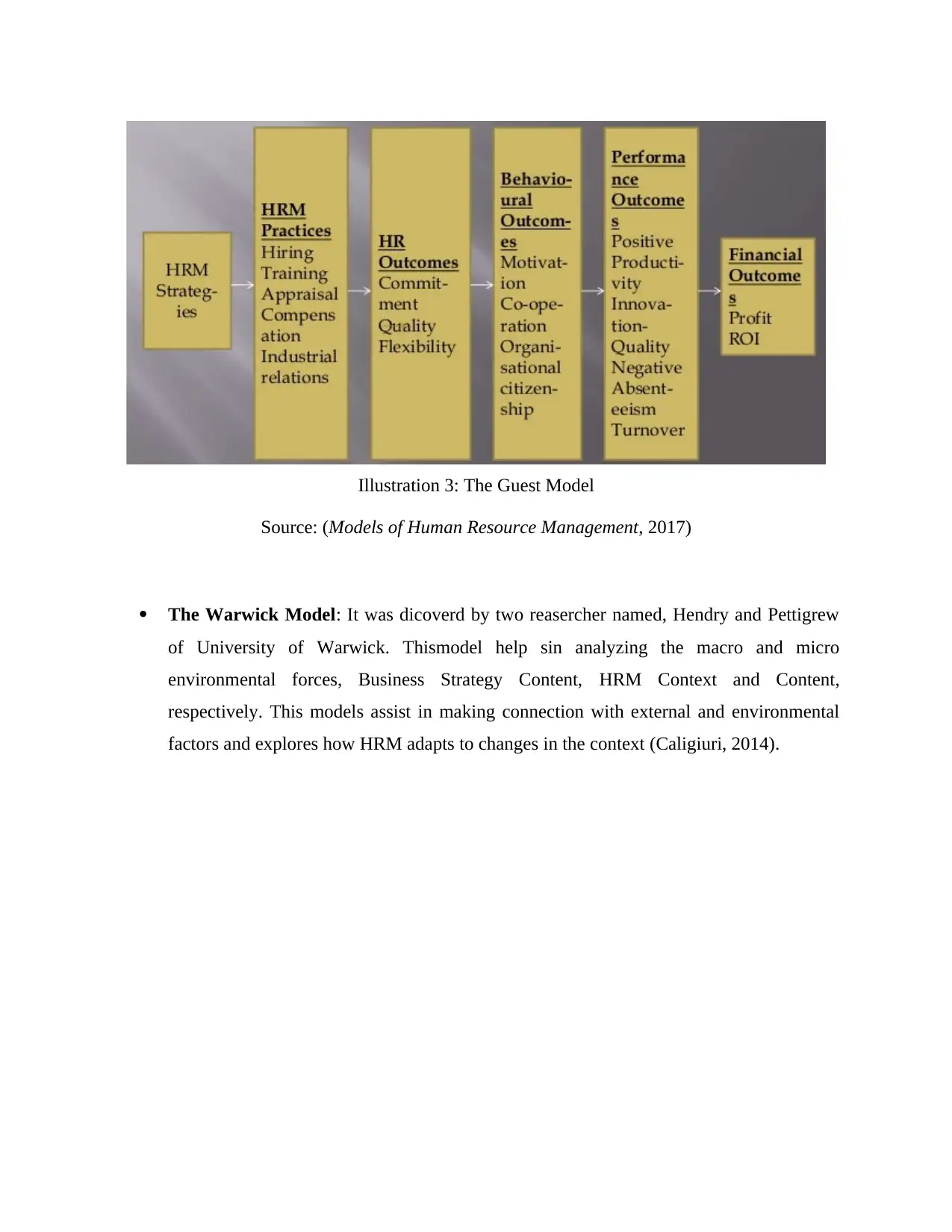
The Warwick Model: It was dicoverd by two reasercher named, Hendry and Pettigrew
of University of Warwick. Thismodel help sin analyzing the macro and micro
environmental forces, Business Strategy Content, HRM Context and Content,
respectively. This models assist in making connection with external and environmental
factors and explores how HRM adapts to changes in the context (Caligiuri, 2014).
Illustration 3: The Guest Model
Source: (Models of Human Resource Management, 2017)
of University of Warwick. Thismodel help sin analyzing the macro and micro
environmental forces, Business Strategy Content, HRM Context and Content,
respectively. This models assist in making connection with external and environmental
factors and explores how HRM adapts to changes in the context (Caligiuri, 2014).
Illustration 3: The Guest Model
Source: (Models of Human Resource Management, 2017)
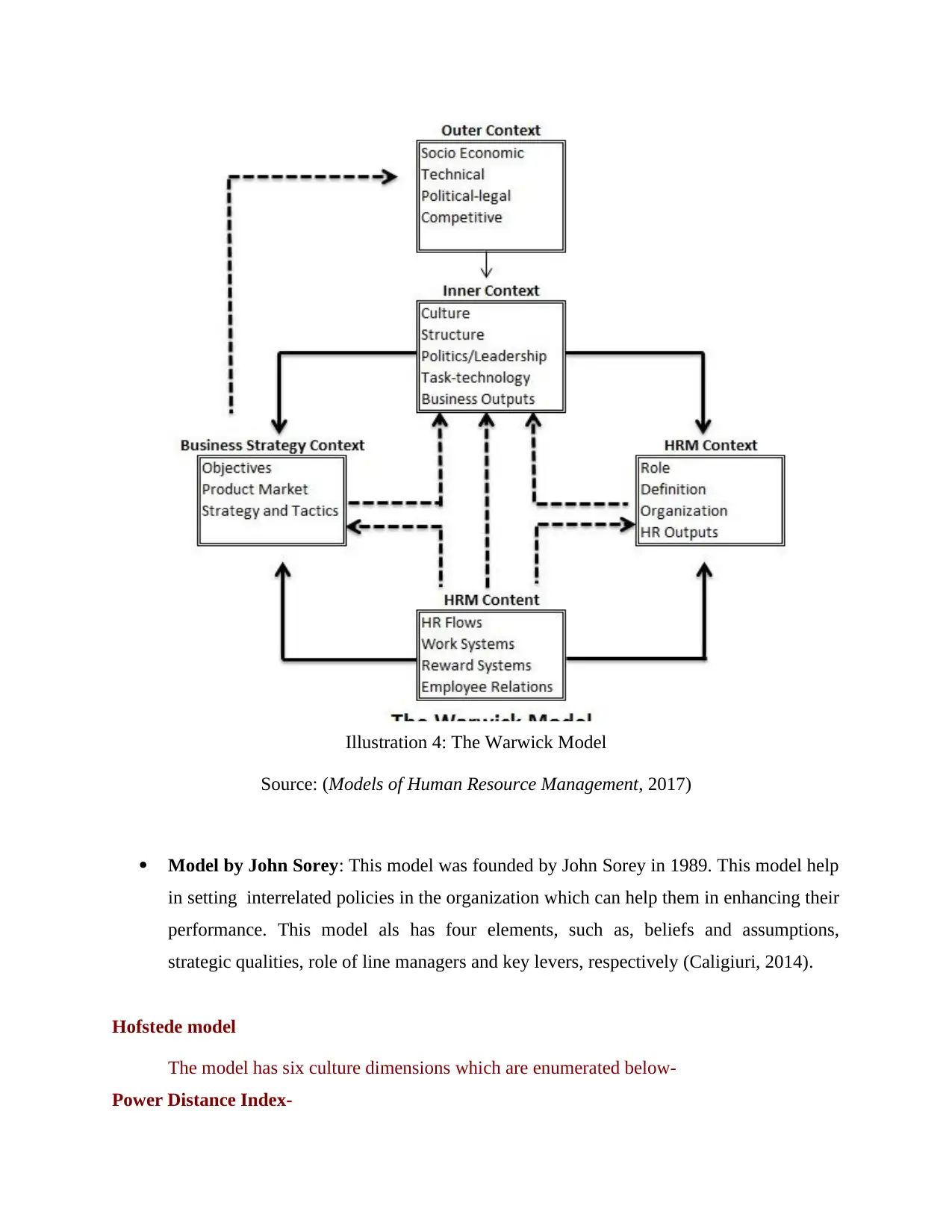
Model by John Sorey: This model was founded by John Sorey in 1989. This model help
in setting interrelated policies in the organization which can help them in enhancing their
performance. This model als has four elements, such as, beliefs and assumptions,
strategic qualities, role of line managers and key levers, respectively (Caligiuri, 2014).
Hofstede model
The model has six culture dimensions which are enumerated below-
Power Distance Index-
Illustration 4: The Warwick Model
Source: (Models of Human Resource Management, 2017)
in setting interrelated policies in the organization which can help them in enhancing their
performance. This model als has four elements, such as, beliefs and assumptions,
strategic qualities, role of line managers and key levers, respectively (Caligiuri, 2014).
Hofstede model
The model has six culture dimensions which are enumerated below-
Power Distance Index-
Illustration 4: The Warwick Model
Source: (Models of Human Resource Management, 2017)
⊘ This is a preview!⊘
Do you want full access?
Subscribe today to unlock all pages.

Trusted by 1+ million students worldwide
1 out of 24
Related Documents
Your All-in-One AI-Powered Toolkit for Academic Success.
+13062052269
info@desklib.com
Available 24*7 on WhatsApp / Email
![[object Object]](/_next/static/media/star-bottom.7253800d.svg)
Unlock your academic potential
Copyright © 2020–2025 A2Z Services. All Rights Reserved. Developed and managed by ZUCOL.




